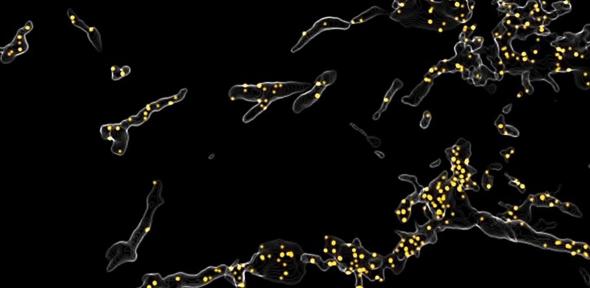
The image shows alpha synuclein oligomers (yellow) inside microglia, the immune cells of the brain. These structures have long been hypothesised to exist but not previously directly observed in Parkinson’s disease. Photo credits: TheLeeLab
For the first time, scientists have directly visualised and measured the tiny protein clusters, called alpha-synuclein oligomers, thought to trigger Parkinson’s disease in human brain tissue.
Previously undetectable, these oligomers are now observable using a new imaging technique called ASA-PD (Advanced Sensing of Aggregates for Parkinson’s Disease), which uses ultra-sensitive fluorescence microscopy to detect and analyse millions of oligomers in post-mortem brain samples. “This is the first time we've been able to look at oligomers directly in human brain tissue at this scale; it’s like being able to see stars in broad daylight,” said co-first author Dr Rebecca Andrews, from TheLeeLab.
The study, led by researchers from the Yusuf Hamied Department of Chemistry at Cambridge, UCL, the Francis Crick Institute, and Polytechnique Montréal, and published in Nature Biomedical Engineering, found that while oligomers exist in both healthy and Parkinson’s brains, those in Parkinson’s brains are larger, brighter, and more numerous. The team also identified a sub-class of oligomers unique to Parkinson’s patients, potentially marking the disease years before symptoms appear.
For more than a century, doctors have recognised Parkinson’s by the presence of large protein deposits called Lewy bodies. But scientists have suspected that smaller, earlier-forming oligomers may cause the damage to brain cells. Until now, these oligomers were simply too small to see – just a few nanometres long.
Professor Steven Lee, at the Yusuf Hamied Department of Chemistry, and co-lead of the study, states: “Lewy bodies are the hallmark of Parkinson’s, but they essentially tell you where the disease has been, not where it is right now. If we can observe Parkinson’s at its earliest stages, that would tell us a whole lot more about how the disease develops in the brain and how we might be able to treat it.”
This breakthrough could help scientists understand how Parkinson’s develops and spreads, guide early diagnostics, and support the creation of targeted therapies. “The only real way to understand what is happening in human disease is to study the human brain directly,” said Professor Sonia Gandhi, from the Francis Crick Institute, and co-lead of the research. “We hope that breaking through this technological barrier will allow us to understand why, where and how protein clusters form and how this changes the brain environment and leads to disease.”
The researchers also note that this technology could be applied to other neurodegenerative disorders such as Alzheimer’s and Huntington’s.
Read the full article here.
Related links: https://www.cam.ac.uk/research/news/parkinsons-trigger-directly-observed...
